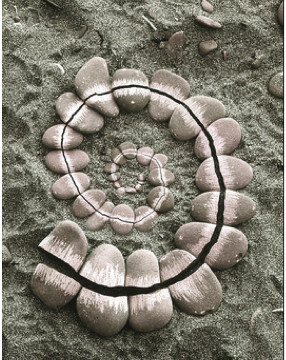When In Wilderness: Applying wilderness wisdom to navigating the current pandemic
By Karl Johnson M.A.
Our present situation with the novel coronavirus has thrust us all into new terrains - a wilderness of uncertainty. When that happens, it’s easy to feel disorientation and even trepidation - especially if one is unaccustomed to traversing such terrains. The complexity of wild environments and shifting variables, such as weather, all necessitate the need to steadfastly and bravely assess and meet new situations head-on with commitment. Being in wilderness can also evoke a feeling of excitement and curiosity. The unknown holds opportunities. A sense of adventure can arise. In life, adventures invigorate us.
Here are some guiding thoughts gleaned from many years of leading wilderness experiences. May these be helpful metaphors in navigating our current, uncertain landscapes.
- Orient Yourself to Your New Surrounding and to Those with You:
Start to pay attention to what is around you. What resources do you have? Where is your water? What is your orientation to the earth and sky? Who is with you? Being observant, alert, and identifying your essential resources that will help you survive physically, mentally, and spiritually. How do we take stock of what useful resources we have with us right now and what is close at hand?. Have we been practicing for contingencies? Do we have a resource of people in our community we can count on? Is there a way to accentuate strengths right now? Are there new opportunities that we see around us in this new landscape? Remember the essentials. Find the “waters” that will sustain you and protect the source. Make sure you keep practicing as a meditant to keep those “waters” flowing. Trust in life and the guidance of the spiritual world.
- Establish your Camp:
Create a safe shelter. Protect oneself from the elements. Be prepared for sudden changes in the weather. Choose your site carefully. A home base is the foundation of safety in your journey. It allows you protection, support, and security. By having a secure base, one can venture forth, but also retreat. There may be dramatic shifts in the “weather,” but you can take shelter in what you have created as a “ base camp.” Safety and security are foundational. Ground yourself nightly in the security of what is your well-made and well-maintained shelter. This can be your actual home, but also the safety and security of one’s nightly practice, which we build up every evening. “Building one’s hut” gives one the opportunity to begin to practice gratitude. Gratitude is the attitude that will change everything.
- Quiet your Mind:
Stay calm. Mindfulness, on the trail and at home, is key to being resilient, flexible, and centered. Remember you are the “decisive element” in this moment in the wilderness. Practice mindfulness and steadfast courage. As the saying goes, “Worry never lessens tomorrow’s problem, but rather robs today of its strength.” Focus on the positive. Take deep breaths. Cultivate a still mind even amid the thunderstorms of the wilderness.
- Listen to All that is Around You:
Listen intently. Attune to what is being intoned in the wilderness around you. Notice the wind. Listen to the “voices” around you. The capacity to listen in many different ways – to yourself, to your body, to others around you, and to the world at large is key to helping you stay focused. This includes all who are near and dear to you. And especially the “quiet “voices that we only hear if we ourselves are quiet. There may be other voices clamoring for our attention. We should learn how to listen carefully to dissenting voices. But learn also how to separate what is “essential from what is not essential.” Seek to hear the quiet voice of inner guidance.
- Be Aware of the Sun:
When and where is the sun rising? When and where is it setting? What is its arc during the day? Can you orient to the sun and find the right daily rhythms? The path of the sun through our days and regular daily rhythms are essential in new (and even in familiar) environments. In rhythm is strength. Be aware of the “Sun” - the big picture of guiding forces in our lives. Remember there are larger patterns in motion. Through these larger motions, seek to find your rhythms and steadfastly maintain them. Rhythm replaces strength - and rhythm awakens life. We also benefit greatly when we remember that “wisdom lives in the light.” Focus on the light.
- Tend Your Fires:
At the end of every day, the night will come. Have you gathered your woodpile? Have you kept your tinder dry? Warmth is an essential of survival – whether in the wilderness or in your daily life. Especially when the new technology provides no supportive physical warmth – like a fire that won't stay lit or burns too small. When the light fades, we can tend our fire. Through the darkness, can we remember our core passions? What actually inspires and motivates us? How do we attend to those motivations when darkness encroaches? Remember, we need some preparation beforehand. Gather and sort the resources of your “woodpile.” Lay your fire well. Start small and feed it carefully. If we are not careful our “fire” can easily become wild. A well-laid and well-tended fire will burn steadily and then, at evening's end, we can enjoy the abiding, glowing embers of our efforts.
- Notice the Stars:
When the fire dies away, gaze upward. The stars, which have always been there, will now be revealed. Take time to marvel and ponder. A sense of wonder and awe are not just gifts but significant aspects of any journey. The stars are always above us at night, but do we take the time to notice? What secrets are arrayed before us in their nightly sweep?
What are the patterns which have “constellated” for us in this lifetime? Can we truly “re-member?” In other words, can we integrate all those parts of ourselves - even from pre-earthly existence - and remember what we said we would do in this lifetime? In so many ways, life is about remembering what we said we would do - before this incarnation - and doing it. The stars can help us “re-member”...
Karl Johnson, presently the Pedagogical Chair for the Santa Fe Waldorf School, is approaching his 35th year as a Waldorf Educator. He has also been an Outdoor Educator for the National Outdoor Leadership School (NOLS) and founded the Santa Fe Waldorf High School Wilderness Experience Program. If you are planning real wilderness journeys for yourself or for your school or if you need help navigating the strange, new world we are experiencing, feel free to contact Karl for some advice. A guide is always helpful. An experienced mentor, consultant, and trainer, Karl Johnson has mentored and trained teachers at dozens of schools in the U.S. and internationally. He still goes out to rejuvenate himself in the wilderness at every opportunity.
kjohnsoneducator@ gmail.com website: www.karljohnsoneducator.com


